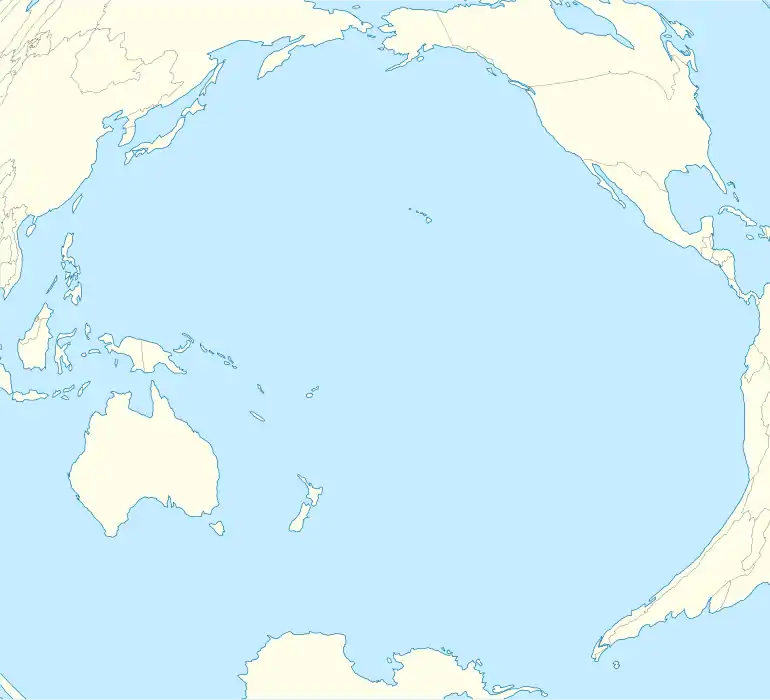.jpg.webp) Senyavin Islands (Pohnpei/Ponape plus two neighboring atolls) | |
 Senyavin Islands | |
| Geography | |
|---|---|
| Location | Pacific Ocean |
| Coordinates | 6°50′N 158°08′E / 6.833°N 158.133°E |
| Archipelago | Caroline Islands |
| Total islands | 3 |
| Major islands | Pohnpei,Ant Atoll,Pakin Atoll |
| Area | 337 km2 (130 sq mi) |
| Highest elevation | 782 m (2566 ft) |
| Highest point | Mount Nanlaud |
| Administration | |
| State | Pohnpei State |
| Largest settlement | Kolonia (pop. 6,000) |
| Demographics | |
| Population | 34,000 |
| Additional information | |
| Time zone | |
The Senyavin Islands belong to the Federated States of Micronesia. They consist of a larger volcanic Pohnpei Island (about 334 km2) and two small atolls Ant and Pakin.
History

On Pohnpei, pre-colonial history is divided into three eras: Mwehin Kawa or Mwehin Aramas (Period of Building, or Period of Peopling, before ca. 1100); Mwehin Sau Deleur (Period of the Lord of Deleur, ca. 1100[1] to ca. 1628);[note 1] and Mwehin Nahnmwarki (Period of the Nahnmwarki, ca. 1628 to ca. 1885).[2][5] Pohnpeian legend recounts that the Saudeleur rulers, the first to bring government to Pohnpei, were of foreign origin. The Saudeleur centralized form of absolute rule is characterized in Pohnpeian legend as becoming increasingly oppressive over several generations. Arbitrary and onerous demands, as well as a reputation for offending Pohnpeian deities, sowed resentment among Pohnpeians. The Saudeleur Dynasty ended with the invasion of Isokelekel, another semi-mythical foreigner, who replaced the Saudeleur rule with the more decentralized nahnmwarki system in existence today.[7][8][9]
For the Europeans these islands were discovered first by Pedro Fernández de Quirós[10] On 10 September 1825 Captain Row, in the brig John Bull passed within 40 miles from some islands at 6°47′N 158°1′E / 6.783°N 158.017°E as he was sailing from New South Wales to Canton. He did not approach more closely as he sighted five boats that gave chase. John Bull was lightly armed and so Row was unwilling to interact with them, choosing instead to sail on. He believed the islands were unknown and so named them "John Bull's Islands".[11] In 1828 Russian navigator Fyodor Litke named the group after Russian admiral Dmitry Senyavin.[12]
Notes
References
- ↑ Flood, Bo; Strong, Beret E.; Flood, William (2002). Micronesian Legends. Bess Press. pp. 145–7, 160. ISBN 1-57306-129-8. Retrieved 1 January 2012.
- 1 2 Hanlon, David L (1988). Upon a Stone Altar: A History of the Island of Pohnpei to 1890. Pacific Islands Monograph. Vol. 5. University of Hawaii Press. pp. 13–25. ISBN 0-8248-1124-0. Retrieved 1 January 2012.
- ↑ Cordy, Ross H (1993). The Lelu Stone Ruins (Kosrae, Micronesia): 1978–81 Historical and Archaeological Research. Asian and Pacific Archaeology. Social Science Research Institute, University of Hawaii at Manoa. pp. 14, 254, 258. ISBN 0-8248-1134-8. Retrieved 31 December 2011.
- ↑ Morgan, William N (1988). Prehistoric Architecture in Micronesia. University of Texas Press. pp. 60, 63, 76, 85. ISBN 0-292-76506-1. Retrieved 31 December 2011.
- 1 2 Panholzer, Tom; Rufino, Mauricio (2003). Place Names of Pohnpei Island: Including And (Ant) and Pakin Atolls. Bess Press. pp. xiii, xii, 101. ISBN 1-57306-166-2. Retrieved 31 December 2011.
- ↑ Micronesica. University of Guam. 1990. pp. 92, 203, 277. Retrieved 31 December 2011.
- ↑ Riesenberg, Saul H (1968). The Native Polity of Ponape. Contributions to Anthropology. Vol. 10. Smithsonian Institution Press. pp. 38, 51. Retrieved 1 January 2012.
- ↑ Ballinger, Bill Sanborn (1978). Lost City of Stone: The Story of Nan Madol, the "Atlantis" of the Pacific. Simon and Schuster. pp. 45–8. ISBN 0-671-24030-7. Retrieved 31 December 2011.
- ↑ Petersen, Glenn (1990). "Isokelekel". Lost in the Weeds: Theme and Variation in Pohnpei Political Mythology (PDF). Occasional Papers. Center for Pacific Islands Studies, School of Hawaiian, Asian & Pacific Studies, University of Hawaiʻi at Mānoa. pp. 34 et seq. hdl:10125/15545. OP35. Retrieved 31 December 2011.
- ↑ History - Quirós Archived 2009-04-17 at the Wayback Machine
- ↑ "Nautical Information". Colonial Times and Tasmanian Advertiser (Hobart, Tasmania), 25 May 1827, p.4.
- ↑ History - Litke Archived 2009-04-17 at the Wayback Machine